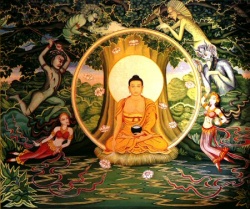Difference between revisions of "Paramārtha-satya"
| Line 1: | Line 1: | ||
[[File:Ma-buddha.jpg|thumb|250px|]] | [[File:Ma-buddha.jpg|thumb|250px|]] | ||
| + | <poem> | ||
'''[[paramārtha-satya]]''' ([[Sanskrit]]). [[Absolute Truth]] or [[absolute reality]]. The ultimate level of [[Truth]] or {{Wiki|reality}} which denotes direct {{Wiki|experience}} devoid of an overlay of conceptualization, and stands in contrast to ‘[[relative Truth]]’ ([[saṃvṛti-satya]]). Both terms are used {{Wiki|epistemologically}} as well as {{Wiki|ontologically}} in [[Mahāyāna]] [[Buddhist]] [[Thought]]. | '''[[paramārtha-satya]]''' ([[Sanskrit]]). [[Absolute Truth]] or [[absolute reality]]. The ultimate level of [[Truth]] or {{Wiki|reality}} which denotes direct {{Wiki|experience}} devoid of an overlay of conceptualization, and stands in contrast to ‘[[relative Truth]]’ ([[saṃvṛti-satya]]). Both terms are used {{Wiki|epistemologically}} as well as {{Wiki|ontologically}} in [[Mahāyāna]] [[Buddhist]] [[Thought]]. | ||
མཚན་ཉིད། མདོ་སྡེ་པའི་ལུགས་ལ། དོན་དམ་པར་དོན་བྱེད་ནུས་པའི་ཆོས། | མཚན་ཉིད། མདོ་སྡེ་པའི་ལུགས་ལ། དོན་དམ་པར་དོན་བྱེད་ནུས་པའི་ཆོས། | ||
| − | a phenomenon that is ultimately able to perform a function [thus phenomena such as pots, etc. are ultimate truths in this system | + | a phenomenon that is ultimately able to perform a function [thus phenomena such as pots, etc. are [[ultimate truths]] in this system |
Synonyms: དངོས་པོ། མི་རྟག་པ། བྱས་པ། འདུས་བྱས། རྒྱུ། འབྲས་བུ། རང་མཚན། མངོན་གྱུར། མངོན་སུམ་གྱི་སྣང་ཡུལ། | Synonyms: དངོས་པོ། མི་རྟག་པ། བྱས་པ། འདུས་བྱས། རྒྱུ། འབྲས་བུ། རང་མཚན། མངོན་གྱུར། མངོན་སུམ་གྱི་སྣང་ཡུལ། | ||
| − | ultimate truths are understood in different ways by the various Buddhist systems; see definition | + | [[ultimate truths]] are understood in different ways by the various [[Buddhist]] systems; see definition heading |
| − | + | Comment: The Sanskrit for [[ultimate truth]], [[paramārthasatya]], is etymologized three ways within identifying ''parama'' as highest or ultimate, ''artha'' as object, and ''satya'' as [[truth]]. | |
| − | In | + | In the first way, ''parama'' (highest, ultimate) refers to a [[consciousness]] of [[meditative]] equipoise directly realizing [[emptiness]]; artha (object) refers to the object of that [[consciousness]], [[emptiness]]; and satya ([[truth]]) also refers to [[emptiness]] in that in direct [[perception]] [[emptiness]] appears the way it exists; that is, there is no discrepancy between the mode of appearance and the mode of being. |
| − | In the | + | In this interpretation, a [[paramārthasatya]] is a [[truth]]-that-is-an-object-of-the-highest-[[consciousness]]. In the second way, both ''parama'' (highest, ultimate) and artha (object) refer to a [[consciousness]] of [[meditative]] equipoise directly realizing [[emptiness]] in that, in the broadest meaning of object, both objects and subjects are objects, and a [[consciousness]] of [[meditative]] equipoise directly realizing [[emptiness]] is the highest [[consciousness]] and thus highest object; ''satya'' ([[truth]]), as before, refers to [[emptiness]]. In this second interpretation, a [[paramārthasatya]] is an [[emptiness]] that exists the way it appears to a highest consciousness, a truth-of-a-highest-object. |
| − | ultimate truth [paramaartha-satya] absolute truth, ultimate truth. essence or literal meaning of the absolute truth; ultimate reality | + | In the third {{Wiki|etymology}}, all three parts refer to emptiness in that an emptiness is the highest (the ultimate) and is also an object and a truth, a truth-that-is-the-highest-object. [[Chandrakīrti]], the chief Consequentialist, favors the third etymology in his Clear Words' |
| + | |||
| + | [[ultimate truth]] [[paramaartha-satya]] [[absolute truth]], [[ultimate truth]]. essence or literal meaning of the [[absolute truth]]; [[ultimate reality]] | ||
See also [[Two Truths]]. | See also [[Two Truths]]. | ||
| + | </poem> | ||
{{R}} | {{R}} | ||
[http://www.answers.com/topic/param-rtha-satya www.answers.com] | [http://www.answers.com/topic/param-rtha-satya www.answers.com] | ||
Revision as of 11:46, 22 July 2013
paramārtha-satya (Sanskrit). Absolute Truth or absolute reality. The ultimate level of Truth or reality which denotes direct experience devoid of an overlay of conceptualization, and stands in contrast to ‘relative Truth’ (saṃvṛti-satya). Both terms are used epistemologically as well as ontologically in Mahāyāna Buddhist Thought.
མཚན་ཉིད། མདོ་སྡེ་པའི་ལུགས་ལ། དོན་དམ་པར་དོན་བྱེད་ནུས་པའི་ཆོས།
a phenomenon that is ultimately able to perform a function [thus phenomena such as pots, etc. are ultimate truths in this system
Synonyms: དངོས་པོ། མི་རྟག་པ། བྱས་པ། འདུས་བྱས། རྒྱུ། འབྲས་བུ། རང་མཚན། མངོན་གྱུར། མངོན་སུམ་གྱི་སྣང་ཡུལ།
ultimate truths are understood in different ways by the various Buddhist systems; see definition heading
Comment: The Sanskrit for ultimate truth, paramārthasatya, is etymologized three ways within identifying parama as highest or ultimate, artha as object, and satya as truth.
In the first way, parama (highest, ultimate) refers to a consciousness of meditative equipoise directly realizing emptiness; artha (object) refers to the object of that consciousness, emptiness; and satya (truth) also refers to emptiness in that in direct perception emptiness appears the way it exists; that is, there is no discrepancy between the mode of appearance and the mode of being.
In this interpretation, a paramārthasatya is a truth-that-is-an-object-of-the-highest-consciousness. In the second way, both parama (highest, ultimate) and artha (object) refer to a consciousness of meditative equipoise directly realizing emptiness in that, in the broadest meaning of object, both objects and subjects are objects, and a consciousness of meditative equipoise directly realizing emptiness is the highest consciousness and thus highest object; satya (truth), as before, refers to emptiness. In this second interpretation, a paramārthasatya is an emptiness that exists the way it appears to a highest consciousness, a truth-of-a-highest-object.
In the third etymology, all three parts refer to emptiness in that an emptiness is the highest (the ultimate) and is also an object and a truth, a truth-that-is-the-highest-object. Chandrakīrti, the chief Consequentialist, favors the third etymology in his Clear Words'
ultimate truth paramaartha-satya absolute truth, ultimate truth. essence or literal meaning of the absolute truth; ultimate reality
See also Two Truths.
